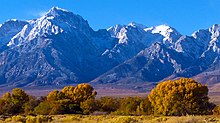A giant perpetual wave of granite, ready to crash onto the Owens Valley floor; this is the Sierra Nevada Mountain Range, a huge block of granite, a batholith, hundreds of miles long and up to 2 miles high.
 |
Sierra Nevada Escarpment Seen From Owens Valley courtesy Wikipedia
|
Its daunting height has changed the US western interior from a Miocene grassland savanna to the desiccated rock strewn deserts of today. This mountain wall blocks the westward march of Pacific rainstorms called the "rain shadow." The Sierra keeps nearly all the water for itself and rarely shares. But this selfish act has a consequence …erosion by glaciers.
The Sculptor
The process of erosion by glaciers is the grinding of granite from gravel and sand under tons of ice, like sandpaper. A lot of rounded granite surfaces, like those in Yosemite, are appreciated from a distance; but as you get closer they look and feel relatively rough…relative to polished granite.
One of the finest places to see polished granite is near Pine Lake out of Pine Creek Canyon behind Mt Tom west of Bishop, Ca. Elsewhere in the Sierra are small remnant crusts of shiny rock, but here you'll find whole slabs of burnished rock.
The Hike
 A number of years ago, Paula and I hiked the strenuous trail to Pine Lake. We were nearly at the lake when we saw glistening rocks lit up by the late afternoon sun. We didn’t stop to inspect since we didn’t want to squander our efforts to reach the lake. On our way back we allowed a few minutes to inspect the shiny slabs. Good thing we waited; we would never have reached the lake. It was an astonishing display of polished granite smooth enough to sit and slide onl. Our stay was short since the sun was setting and we had a long journey back. Years later we returned, this time with cameras.
A number of years ago, Paula and I hiked the strenuous trail to Pine Lake. We were nearly at the lake when we saw glistening rocks lit up by the late afternoon sun. We didn’t stop to inspect since we didn’t want to squander our efforts to reach the lake. On our way back we allowed a few minutes to inspect the shiny slabs. Good thing we waited; we would never have reached the lake. It was an astonishing display of polished granite smooth enough to sit and slide onl. Our stay was short since the sun was setting and we had a long journey back. Years later we returned, this time with cameras.The Pix
A lapidary’s rock tumbler uses a series of smaller and smaller grit to shape rock and eventually polish to a shine. Its incredible to think this has been done on such an enormous scale.
 Just off the trail are these blocks of granite, one of hundreds that have retained smooth undulating surfaces despite being shattered by unknown forces and strewn across the hillside.
Just off the trail are these blocks of granite, one of hundreds that have retained smooth undulating surfaces despite being shattered by unknown forces and strewn across the hillside. These are Chatter Marks, a series of marks made by vibratory chipping of a bedrock surface by rock fragments carried in the base of a glacier.
These images are from an iPhone. Additional images taken with a Canon in the near future


